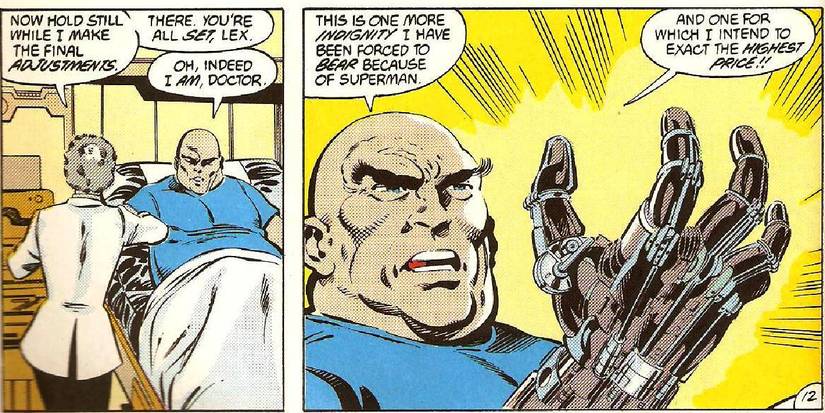Although Superman usually escapes the devastating effects of green Kryptonite, the mineral may still doom the Man of Steel to a slow and painful death. Under Earth’s yellow sun, Superman's cells function like living solar batteries, absorbing and storing energy that fuels his strength. Earth's yellow sun transforms Superman into a being capable of withstanding forces that would annihilate most metahumans.
While every type of Kryptonite has a different effect on Superman's physiology, Green Kryptonite is by far the deadliest. Green Kryptonite disables Superman's solar energy absorption, which weakens him and inflicts severe pain. If he's exposed to it for a long time, Superman could easily die. However, Kryptonite's effects may not stop once Superman distances himself away from it.
Kryptonite May Actually Have Permanent Effects On Superman's Health, After All
Repeated Encounters With Green Kryptonite May Eventually Become Deadly To Superman

Superman suffers from Kryptonite poisoning after saving Lex
Superman’s most famous weakness, green Kryptonite, incapacitates him through radiation that directly interacts with his alien physiology. While most attacks can’t pierce Superman's invulnerable body, Kryptonite bypasses it entirely, leaving him weak, in pain, and mostly unable to access his powers. Traditionally, green Kryptonite has been shown as an immediate and temporary danger, only fading once it’s out of range.
The idea of Superman accumulating damage from repeated green Kryptonite exposure has rarely been explored in canon, but it's technically possible. In real life, radiation poisoning doesn’t require massive lethal doses to have long-lasting consequences. Even small but repeated exposures can severely damage cells and mutate DNA. If Kryptonite functions like radiation or toxic minerals like asbestos, then Superman may be facing severe illness.
Superman's Extended Lifespan Gives Kryptonite's Long-Term Effects More Time To Harm Him
Superman's Invulnerability May Eventually Play Against Him

Old Clark Kent wrapped in his Superman cape as an old man in Kingdom Come
Besides granting him superhuman strength, speed, and durability, Superman’s Kryptonian physiology blesses him with a vastly extended lifespan. Under the nourishment of Earth’s yellow sun, Superman's body remains in peak physical condition for decades, perhaps even centuries. This means Superman is uniquely vulnerable to long-term illnesses that regular mortals never face.
That same extended lifespan gives Kryptonite far more time to inflict harm. Prolonged exposure could weaken his immune system, impair his ability to absorb solar energy, or even scar his Kryptonian cells beyond repair. Over years, decades, or centuries of exposure, these accumulated effects may linger within his cells. The result could be impaired energy absorption and thus a variety of secondary ailments.
Lex Luthor Has Suffered From Long-Term Kryptonite Exposure
Superman #19; Written by John Byrne; Art by John Byrne, John Beatty, and Petra Scotese

Lex Luthor suffers from long-term Kryptonite radiation poisoning in Superman #19
In 1988’s Superman #19, Lex Luthor learned the cost of his arrogance after carrying a Kryptonite ring at all times as insurance against Superman. Luthor exposed himself to its radiation day after day for a long time. Unfortunately for him, the result was deadly. Luthor's hand developed severe radiation poisoning, leading to amputation.
In the DC Animated Universe, Kryptonite’s toxicity nearly killed Luthor again. Years of handling the mineral led to an aggressive form of cancer that ravaged his body. Brainiac secretly purged the disease from Lex's system, but his disease still marked one of the clearest examples of Kryptonite’s long-term effects on the human body.
Meanwhile, Batman often avoids Kryptonite’s deadly side effects by storing his emergency shard encased in lead. Still, the danger of Kryptonite exposure in humans only goes to show how deadly it could be to Kryptonians. If prolonged exposure can destroy a human body in years, then centuries of accumulated Kryptonite contact could eventually be nightmarish to the Man of Steel.
DC Has Yet To Explore The Bleakest Superman Death
Superman's Long-Term Kryptonite Illness Is Too Dark For DC Comics

Featured Image: Superman crying out in pain, surrounded by green Kryptonite
Unlike a dramatic sacrifice in battle, a slow death by Kryptonite poisoning would be the most mundane and painfully human way to kill off Superman. Superman would be consumed by the very weakness that has haunted him his entire life. It would be genuinely heartbreaking to see the Man of Steel's once invincible body be eroded gradually.
This kind of death would echo other similarly grim storylines. In Marvel's Spider-Man: Reign, Mary Jane Watson dies from cancer caused by prolonged exposure to Peter Parker’s radioactive body fluids. On the opposite end, Hulk: The End shows Bruce Banner’s torment as Hulk’s Gamma energy won’t let him die, even if his human body wastes away due to his old age.
Such a devastating story would need to be handled with extreme care. Superman's slow and tragic death due to Kryptonite poisoning risks being too bleak for mainstream storytelling. Only writers proven capable of handling this kinds of dark themes would be able to attempt it.






